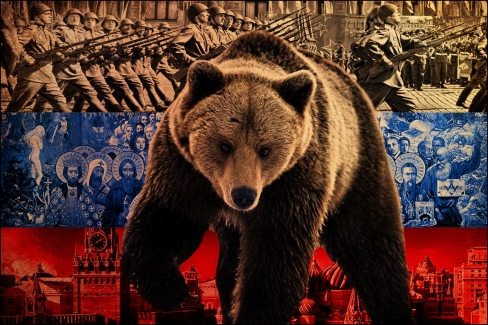In a documentary that aired recently on the Canadian Broadcasting Corporation’s popular The Fifth Estate program, an allegory of Vladimir Putin was presented. The wily Russian president was described growing up in a shabby St. Petersburg apartment, where he would often corner rats.
Now, punished by low oil prices and Western sanctions against Russian incursions in Ukraine/ Crimea, Putin is himself the cornered rat. Many wonder, and fear, what he will do if conditions in Russia become increasingly desperate.
In the last six months oil prices have plunged over 50 percent and the Russian economy is hurting. The country now faces slowing economic growth, a depressed ruble, and runaway inflation estimated to be up to 150 percent on basic foodstuffs.
The Kremlin is counting on austerity cuts to help balance its budget, which has revenues coming in at $45 billion lower than earlier projections. The exception, significantly, is defense. With the military exempted from the austerity plan, it begs the question of whether Putin will “play the nationalist card,” such as he did in Crimea, in an effort to strengthen greater Russia during a period of economic weakness.
Georgia On His Mind
We are already seeing this to be the case. As Oilprice.com reported on Tuesday, Putin is set to absorb South Ossetia – Georgia’s breakaway republic that declared itself independent in 1990. Under an agreement “intended to legalize South Ossetia’s integration with Russia,” Russia would invest 2.8 million rubles (US$50 million) to “fund the socio-economic development of South Ossetia,” according to Agenda.GE, a Tbilisi-based news site.
The situation is analogous to Crimea because, like Crimea, South Ossetia contains a significant Russian-speaking population with ties to the Motherland.
If Putin succeeds in annexing the tiny province, it will be a real poke in the eye to the United States, which provoked Russia in the early 1990s by promoting construction of a pipeline between the former Soviet republics of Azerbaijan and Georgia. The BTC pipeline moves oil from Baku in Azerbaijan to Tbilisi in Georgia and then onward to Ceyhan on Turkey’s Mediterranean coast.
BTC started operating in 2006. Then, two years later, Putin built his own pipeline to cut out Georgia. The South Ossetia pipeline run by Gazprom stretches 75 kilometers from South Ossetia to Russia.
The current move on South Ossetia is a way for Russia to assert its energy independence in the face of Western sanctions and low oil prices.
It comes as Russia announced plans to divert all of its natural gas crossing Ukraine to a route via Turkey. As Bloomberg reported last week, Gazprom will send 63 billion cubic meters through a proposed link under the Black Sea to Turkey – after the earlier South Stream pipeline, a $45-billion project that would have crossed Bulgaria, was scrapped by Russia amid opposition from the European Union. By sending the gas to Turkey and on to Europe via Greece, Gazprom is in effect sending Europe an ultimatum: build pipelines to European markets, or we will sell the gas to other customers.
According to one observer, the proposed land grab in South Ossetia combined with the snub to Europe by shifting its gas to Turkey and bypassing Ukraine, is a classic Putin power play:
“Russia is preparing to absorb a province of neighboring Georgia, and delivering an ultimatum to Europe that it could lose much of the Russian gas on which it relies,” Steve LeVine writes in Quartz. “Putin has argued that the west is simply intent on ousting him and weakening Russia… Faced with these perceived attempts to undercut him and his country, Putin suggests that he has no choice but to pull around the wagons and stick it out. This could go on a long time.”
Iran: Falling Oil Prices Spur Peace Dividend
Some have speculated that the oil price crash was orchestrated by the Saudis, possibly in collusion with the United States and other Gulf states, to punish Iran, its main political and religious rival in the Middle East.
Whether or not that is true, there is no denying the effects of a low oil price on Iran’s economy. “Iran is already missing tens of billions of dollars in oil revenue due to Western sanctions and years of economic mismanagement under former President Mahmoud Ahmadinejad,” Bloomberg reported on Jan. 7. Like Russia, Iran is looking at spending cuts in next year’s budget, which is based on an overly-optimistic $72 a barrel crude oil price.
However, unlike Russia, which is “circling the wagons” and pulling further away from the West currently, the oil price drop could actually lead to more of a détente between Iran and Western countries. In a speech on Jan. 4, President Hassan Rouhani said Iran’s economy “cannot develop in isolation from the rest of the world,” while at the same time, Iran’s foreign minister was negotiating a nuclear deal that could see the lifting of UN sanctions, the Washington Post observed.
Then there is the cooperation between the West and Iran over the terrorist group ISIS. The National Post’s J.L. Granatsein wrote in a column on Tuesday that Iran has deployed substantial numbers of its Revolutionary Guard elite Al Qods brigade into Iraq and Syria to fight ISIS, along with Western allies including the US, Britain, France and Canada. This is despite Iran’s support for Hezbollah in Lebanon and Syria’s president Assad.
“Politics makes strange bedfellows indeed, but not much can be stranger than this. Led by the Americans, hitherto the Great Satan to the Iranian leaders, the ties between the West and Iran are becoming tighter, each side reacting to the horrors of Islamist fundamentalism throughout the region,” Granatsein writes. “The Iranians have been hurt by sanctions, and they are being wracked even more by the falling price of oil. Easing curbs on trade and Iranian banks may mitigate the effects of the oil price collapse.”
Venezuela Bracing For The Worst
The other major loser in the oil price collapse, Venezuela, may not see such a positive outcome. Wracked by decades of economic mismanagement by Hugo Chávez, the South American oil producer was already struggling to pay its debts when new president Nicolás Maduro came to power.
Now, with inflation running at 60 percent and lines forming outside state grocery stores for food and other basic supplies, Maduro faces the specter of serious social unrest if conditions do not improve. The country has some of the world’s cheapest gasoline prices, but Maduro has refused to end fuel subsidies, fearing, no doubt, a repeat of widespread riots in 1989 that left hundreds dead after gasoline prices were allowed to rise.
Venezuela is even more dependent than Russia on the price of oil, earning some 96 percent of its foreign currency from oil sales, putting Maduro in the untenable position of either borrowing more, despite crushing debts, or slashing spending:
“With only $20 billion left in its reserves, and $50 billion in debt to China alone, Venezuela appears headed toward a choice between abandoning its oil giveaways and defaulting on its debts, or starving its own population to the point of revolt,” according to the Washington Post.
Source: http://oilprice.com/Energy/Energy-General/Crushing-The-U.S.-Energy-Export-Dream.html
By Andrew Topf for Oilprice.com

















